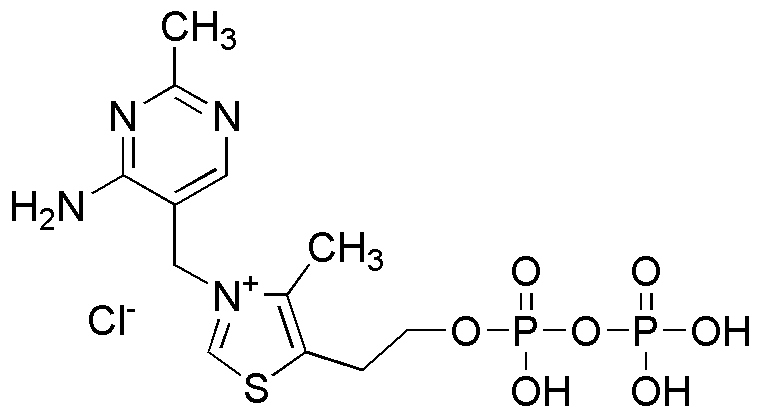Thiamine pyrophosphate is widely utilized in research focused on:
- Enzyme Cofactor: It serves as a crucial cofactor for several enzymes involved in carbohydrate metabolism, making it essential in studies related to energy production and metabolic pathways.
- Neuroscience Research: This compound plays a significant role in neurotransmitter synthesis, particularly in studies investigating cognitive functions and neurodegenerative diseases.
- Food Industry: Thiamine pyrophosphate is used as a food additive to fortify products, enhancing nutritional value and preventing deficiencies in populations at risk.
- Pharmaceutical Development: It is explored in drug formulations aimed at treating metabolic disorders, providing therapeutic benefits by restoring normal metabolic functions.
- Plant Biology: The compound is utilized in agricultural research to study its effects on plant growth and development, particularly in enhancing crop yields through improved nutrient utilization.
Informations générales
Propriétés
Sécurité et réglementation
Applications
Thiamine pyrophosphate is widely utilized in research focused on:
- Enzyme Cofactor: It serves as a crucial cofactor for several enzymes involved in carbohydrate metabolism, making it essential in studies related to energy production and metabolic pathways.
- Neuroscience Research: This compound plays a significant role in neurotransmitter synthesis, particularly in studies investigating cognitive functions and neurodegenerative diseases.
- Food Industry: Thiamine pyrophosphate is used as a food additive to fortify products, enhancing nutritional value and preventing deficiencies in populations at risk.
- Pharmaceutical Development: It is explored in drug formulations aimed at treating metabolic disorders, providing therapeutic benefits by restoring normal metabolic functions.
- Plant Biology: The compound is utilized in agricultural research to study its effects on plant growth and development, particularly in enhancing crop yields through improved nutrient utilization.
Documents
Fiches de données de sécurité (FDS)
La FDS fournit des informations de sécurité complètes sur la manipulation, le stockage et l’élimination du produit.
Spécifications du produit (PS)
Le PS fournit une description complète des propriétés du produit, notamment sa composition chimique, son état physique, sa pureté et les exigences de stockage. Il détaille également les plages de qualité acceptables et les applications prévues du produit.
Certificats d'analyse (COA)
Recherchez des certificats d'analyse (COA) en saisissant le numéro de lot du produit. Les numéros de lot et de lot se trouvent sur l'étiquette d'un produit, après les mots « Lot » ou « Lot de fabrication ».
Numéro de catalogue
Numéro de lot/série
Certificats d'origine (COO)
Ce certificat d'exploitation confirme le pays dans lequel le produit a été fabriqué, et détaille également les matériaux et composants utilisés et s'il est issu de sources naturelles, synthétiques ou autres sources spécifiques. Ce certificat peut être requis pour les douanes, le commerce et la conformité réglementaire.
Numéro de catalogue
Numéro de lot/série
Fiches de données de sécurité (FDS)
La FDS fournit des informations de sécurité complètes sur la manipulation, le stockage et l’élimination du produit.
DownloadSpécifications du produit (PS)
Le PS fournit une description complète des propriétés du produit, notamment sa composition chimique, son état physique, sa pureté et les exigences de stockage. Il détaille également les plages de qualité acceptables et les applications prévues du produit.
DownloadCertificats d'analyse (COA)
Recherchez des certificats d'analyse (COA) en saisissant le numéro de lot du produit. Les numéros de lot et de lot se trouvent sur l'étiquette d'un produit, après les mots « Lot » ou « Lot de fabrication ».
Numéro de catalogue
Numéro de lot/série
Certificats d'origine (COO)
Ce certificat d'exploitation confirme le pays dans lequel le produit a été fabriqué, et détaille également les matériaux et composants utilisés et s'il est issu de sources naturelles, synthétiques ou autres sources spécifiques. Ce certificat peut être requis pour les douanes, le commerce et la conformité réglementaire.


